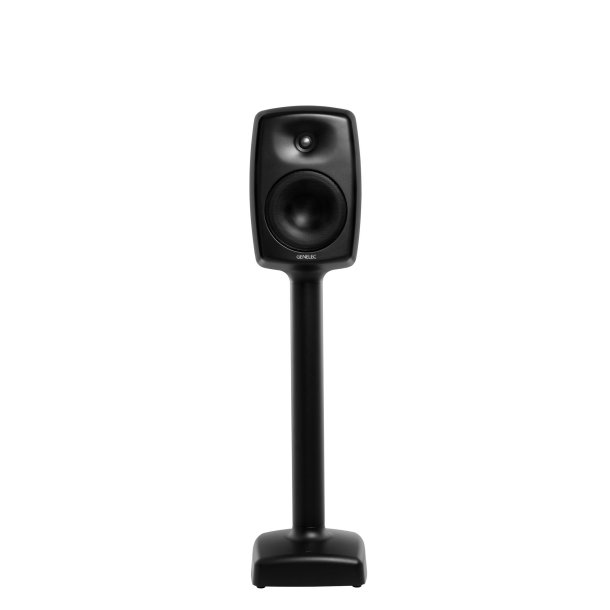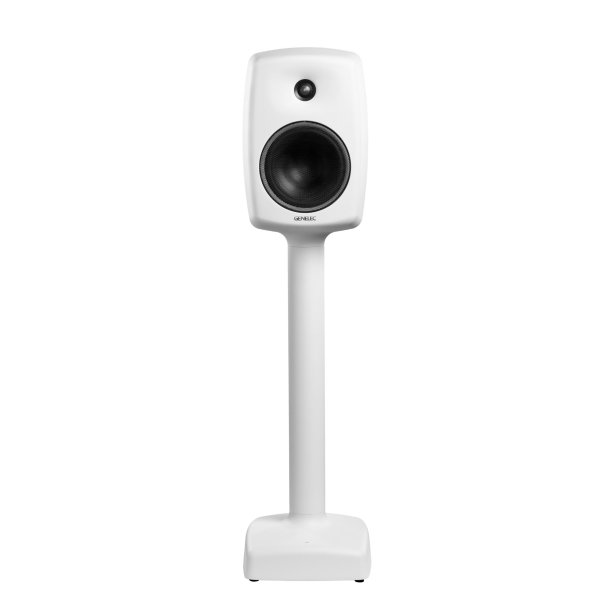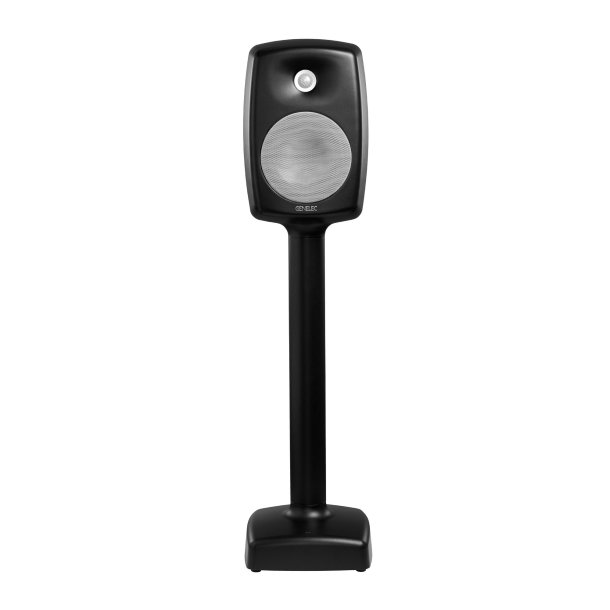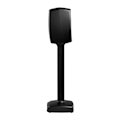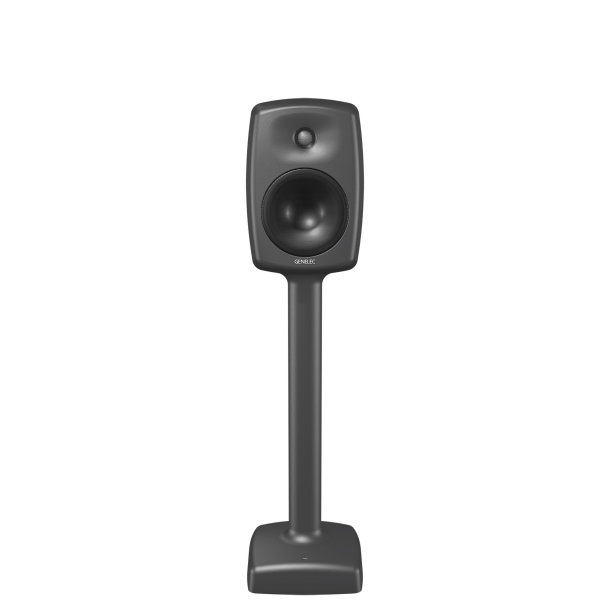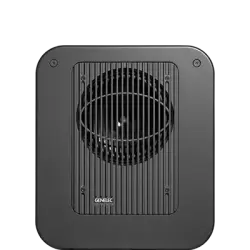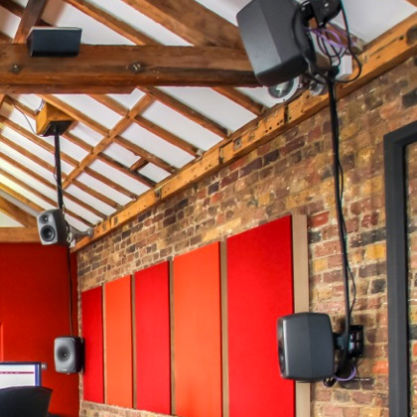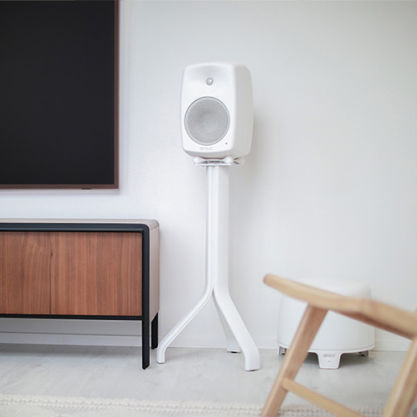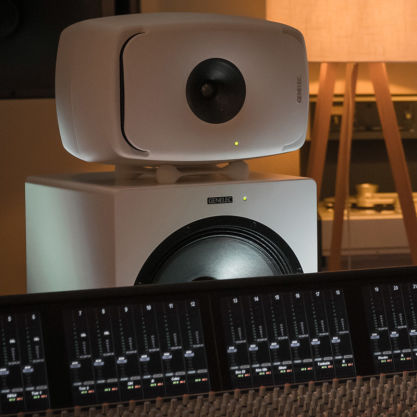Der 6040R vereint das Beste aus finnischer Technologie und Design und bietet allen Liebhabern hochwertiger Audioqualität eine außergewöhnliche Leistung und eine wunderschöne Ästhetik.
6040R
Smart Active Lautsprecher

Smart Active Monitor (SAM™)-Systeme

Directivity Control Waveguide (DCW™)-Technologie

SPL
109 dB

Frequenzgang
43 Hz - 20 kHz (-6 dB)

Abmessungen
H 999 x W 237 x D 220 mm, (Anzeige in Inch)

Ein Lautsprecher, der seiner Zeit bereits voraus war
20 Jahre nach der Markteinführung des ursprünglichen 6040A verfügt der neu konzipierte 6040R nun über professionelle Basstreiber, proprietäre Class-D-Endstufen und alle Vorteile der SAM Technologie mit der Einmessung und Steuerung über unsere GLM Software. Der 6040R bietet eine verzerrungsfreie Wiedergabe, einen durchgängig neutralen und linearen Frequenzgang und eine präzise Stereoabbildung und Tiefenstaffelung - selbst in schwierigen akustischen Umgebungen.

Purer Klang. Finnisches Design.
Das abgerundete Gehäuse des 6040R wurde in enger Zusammenarbeit mit dem führenden Designer Harri Koskinen entwickelt und ist aus druckgegossenem, recyceltem Aluminium. Dieser Designansatz sorgt nicht nur für eine wahrheitsgetreuere, verfärbungsfreie Wiedergabe, sondern bedeutet auch, dass der 6040R zum klanglichen und optischen Mittelpunkt jeder Hörumgebung wird. Der 6040R wird gemäß der höchsten Umweltstandards gebaut und jahrzehntelang störungsfrei funktionieren.
Genelec
6040R Smart Active Loudspeaker White, White Grille
6040R Smart Active Loudspeaker Black, Black Grille
6040R Smart Active Loudspeaker White, Black Grille
6040R Smart Active Loudspeaker Black, White Grille
6040R Smart Active Loudspeaker Grey
6040R
Auszeichnungen
Technische Spezifikationen

SPL
109 dB

Verstärkerleistung
150 W Treble (Class D) + 150 W Bass (Class D)

Frequenzgang
43 Hz - 20 kHz ("-6 dB")

Genauigkeit des Frequenzgangs
± 1.5 dB (50 Hz - 20 kHz)

Treiberabmessungen
⌀ 165 mm Bass + ⌀ 19 mm Treble (Anzeige in Inch)

Abmessungen
H 999 x W 237 x D 220 mm, (Anzeige in Inch)

Gewicht
14.9 kg / 32.8 lb

Anschlüsse
1 x XLR Analog Input
1 x XLR AES/EBU Input
1 x XLR AES/EBU Output
2 x RJ45 Control
6040R Product Specifications
Smart Active Lautsprecher
Technische Spezifikationen
Der 6040R vereint das Beste aus finnischer Technologie und Design und bietet allen Liebhabern hochwertiger Audioqualität eine außergewöhnliche Leistung und eine wunderschöne Ästhetik.

Systemspezifikationen
Frequenzgang
50 Hz - 20 kHz (± 1.5 dB)
Low cutoff -6dB
43 Hz
High cutoff -6dB
20 kHz
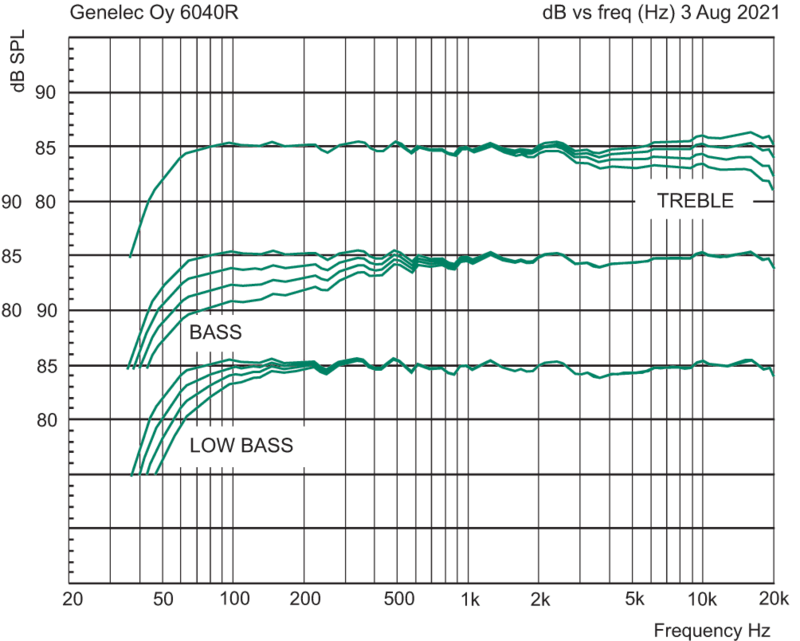
SPL
Peak SPL Maximum peak acoustic output per pair in a listening room with music material at 1 m.
≥118 dB
Kurzzeitiger max. SPL Maximum short term sine wave acoustic output on axis in half space, averaged from 100 Hz to 3 kHz at 1 m.
≥109 dB
Max. Langzeit-SPL Maximum long term RMS acoustic output in the same conditions with IEC weighted noise (limited by driver protection circuit) at 1 m.
≥98 dB
Eigenrauschen
Eigenrauschen Self generated noise level in free space at 1 m on axis (A-weighted).
≤5 dB SPL
Gewicht
Gewicht14.9 kg (32.8 lb)
Abmessungen
Höhe
999 mm
Breite
237 mm
Tiefe
220 mm
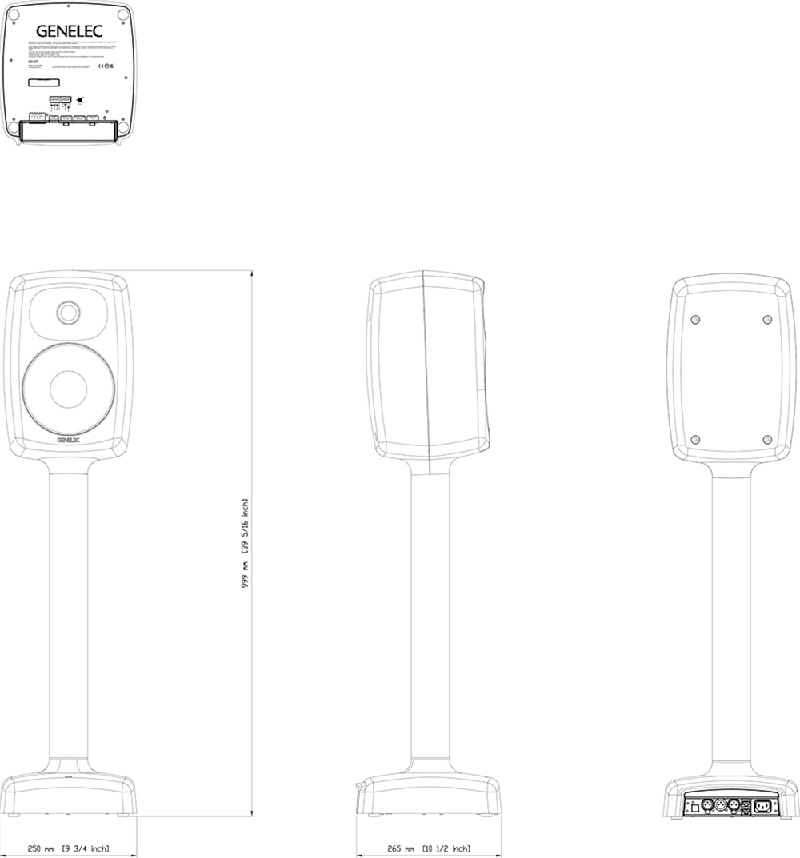
Gehäuse
Gehäusematerial
Die cast aluminium
Gehäusetyp
Sealed box
Treiber
Treiber-Typ
Cone
Magnetically shielded bass driver.
Durchmesser
165 mm
Treiber-Typ
Metal dome
Magnetically shielded treble driver.
Durchmesser
19 mm
Richtwirkung
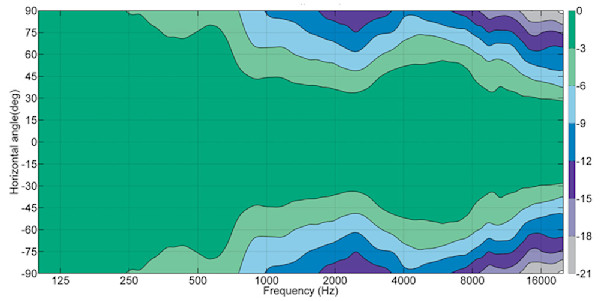
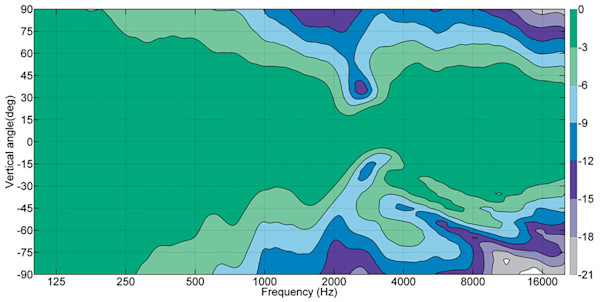
Harmonische Verzerrung
Gruppen-Laufzeit
The latency at high frequencies from the input to the acoustic output, measured in the analog input:
Extended Phase Linearity in GLM set to OFF
2.9 ms
In Genelec performance graphics, the time of converting the from an electronic input signal to the acoustic output in a Genelec monitor is described by two factors – latency and group delay. The group delay factor can be read in the graphics for a specific frequency. The total frequency-specific input-to-output delay is a sum of the latency and group delay factors. To understand the significance of this total delay, consider that moving a loudspeaker away by 1 meter creates an additional delay of about 3 ms.
Abschnitt Verstärker
Verstärker
150 W Class D
150 W Class D
Netzspannung
100-240 VAC 50/60Hz
Stromverbrauch
ISS aktiv
≤1 W
Leerlauf
≤12 W
Volle Leistung
180 W
Abschnitt Signalverarbeitung
Anschlüsse
Input Analog signal input connector XLR female, balanced 10 kOhm.
Input Digital signal input connector XLR female 110 Ohm.
Output Digital signal output / Thru connector XLR male 110 Ohm.
2 x Control Two CAT5 (RJ45) GLM Network connectors for computer control using the Genelec Loudspeaker Manager (GLM) software.
Produktvarianten
Produktcodes
Passendes Zubehör
Produktcodes
Weitere technische Details finden Sie in der Anleitung.
Schlüsseltechnologien

Smart Active Monitor (SAM™)-Systeme

Directivity Control Waveguide (DCW™)-Technologie

Aktive Frequenzweichen

Intelligent Signal Sensing (ISS™)-Technologie

Minimum Diffraction Enclosure (MDE™)-Technologie

Optimierte Verstärker

Schutzschaltungen
Unsere vernetzten Smart Active Monitor (SAM™)-Systeme verfügen über eine automatische Anpassung an Ihre Hörumgebung.

In den letzten zehn Jahren hat die Erstellung von Medieninhalten weltweit rapide zugenommen, was zu erheblichen Veränderungen in der Art und Weise geführt hat, wie Einrichtungen mit der gestiegenen Arbeitsbelastung umgehen. Mehr denn je findet eine wachsende Zahl von Audioproduktionen in kleineren, engeren Arbeitsumgebungen statt. Dadurch verstärken sich häufig akustische Probleme und die Zuverlässigkeit beim Abhören sinkt. Gleichzeitig muss man sich als Profi auf ein präzises Abhörsystem verlassen können, das den Klang neutral und ohne Verfärbungen wiedergibt.
Aufbauend auf den bewährten elektroakustischen Grundlagen unserer Produkte der Serien 1200, 8000 und 7000 sind die fortschrittlichen SAM-Systeme von Genelec die modernsten und flexibelsten Abhörlösungen von heute. Sie sind ein unverzichtbares Werkzeug für Audioprofis, da sie sich automatisch an die akustische Umgebung anpassen und Pegel, Verzögerungen und Frequenzgang korrigieren können. SAM-Systeme können über das Genelec-eigene Loudspeaker Manager (GLM™)-Netzwerk und die entsprechende Software gesteuert werden, so dass Sie ein äußerst flexibles und zuverlässiges Abhörsystem aufbauen können.
Die GLM-Software ist ein intuitives und leistungsfähiges Monitorsteuerungs-Netzwerksystem, das die Verbindung zu allen SAM-Studiomonitoren und Subwoofern im Netzwerk verwaltet - mehr als 80 Geräte falls notwendig. Sie ermöglicht die Einstellung von Pegeln, Abstandsverzögerungen und eine Anpassung des Frequenzgangs mit dem intelligenten automatischen Kalibrierungsalgorithmus AutoCal™. Alle Parameter und Einstellungen werden in System-Setup-Dateien oder für den Stand Alone-Betrieb in jedem einzelnen Monitor oder Subwoofer gespeichert.
Außerdem können alle akustischen Eigenschaften der SAM-Systeme für verschiedene Arbeitsstile oder Kundenanforderungen optimiert werden. Auch ween Sie zwischen verschiedenen Räumen wechseln, können Sie von der SAM-Technologie profitieren und ein Höchstmaß an Konsistenz beim Monitoring erreichen.
Genelec SAM-Systeme bieten eine umfassend skalierbare, lösungsorientierte, intelligent vernetzte Produktpalette, die analoge und digitale Signale in praktisch jeder Arbeitsumgebung unterstützt.
Directivity Control Waveguide (DCW™)-Schallführung für ausgewogene Abstrahlung auf und außerhalb der Hörachse.

Mit der Entwicklung der Directivity Control Waveguide (DCW™)-Schallführung verfolgte Genelec 1983 einen revolutionären Ansatz. Sie wurde damals in einem eiförmigen Gehäuse eingesetzt. Über 30 Jahre entwickelt und immer weiter verfeinert, verbessert sie die Leistung von direkt abstrahlenden Mehrwege-Monitoren erheblich.
Die DCW-Technologie formt die abgestrahlte Wellenfront auf kontrollierte Weise und ermöglicht so eine vorhersehbare Anpassung des Abstrahlverhaltens (Dispersion). Um eine gleichmäßige und ausgewogene Richtcharakteristik zu erreichen, wird der Abstrahlwinkel begrenzt, so dass die Streustrahlung reduziert wird. Dies führt zu einer ausgezeichneten Linearität des gesamten Frequenzgangs sowie zu einem gleichmäßigen Leistungsverhalten. Frühe Reflexionen werden minimiert und man erreicht eine breite und kontrollierte Hörzone, mit einer akkuraten Klangwiedergabe auf und außerhalb der Achse.
Geringe Erstreflexionen und eine kontrollierte, konstante Richtwirkung haben einen weiteren wichtigen Vorteil: Die Frequenzbalance des Raumschallfeldes ist im Wesentlichen die gleiche wie die des Direktfeldes der Monitore. Das hat zur Folge, dass die Leistung des Abhörsystems weniger von den raumakustischen Eigenschaften abhängig ist.
Breite und Tiefe des Klangbildes, kritische Komponenten in jeder Hörumgebung, sind nicht nur für das Hören auf der Achse, sondern auch außerhalb der Achse wichtig. Davon profitieren auch anderen Personen im Raum, die nicht im Sweet Spot sitzen, wie es in großen Regieräumen oft der Fall ist.
DCW™-Technologie Hauptvorteile:
- Lineare On- und Off-Axis-Wiedergabe für einen größeren nutzbaren Hörbereich
- Erhöhtes Verhältnis von Direkt- zu Reflexionsschall für eine geringere Verfärbung durch den Abhörraum
- Verbesserte Stereoabbildung und Tiefenstaffelung
- Erhöhte Empfindlichkeit der Antriebseinheit um bis zu 6 dB
- Erhöhte Kapazität des maximalen Schalldruckpegels des Systems
- Geringere Verzerrung des Chassis
- Geringere Beugung an den Gehäusekanten
- Geringere Verzerrung des gesamten Systems
Aktive Frequenzweichen, die mit niedrigen Signalpegeln arbeiten.

Elektronische Frequenzweichen ermöglichen die Aufteilung des Audiosignals in einzelne Frequenzbänder, die separat an einzelne Leistungsverstärker geleitet werden können, die dann an spezifische, für ein bestimmtes Frequenzband optimierte Wandler angeschlossen werden.
Aktive Frequenzweichen gibt es sowohl in digitaler als auch in analoger Ausführung. Die digitalen aktiven Frequenzweichen von Genelec beinhalten zusätzliche Signalverarbeitung wie Schutzschaltungen, Verzögerung und Entzerrung.
Analoge aktive Frequenzweichen von Genelec enthalten elektronische Komponenten, die mit niedrigen Signalpegeln betrieben werden, die für die Eingänge von Leistungsverstärkern geeignet sind. Dies steht im Gegensatz zu passiven Frequenzweichen, die mit den hohen Signalpegeln der Endverstärkerausgänge arbeiten und dabei hohe Ströme und in einigen Fällen auch hohe Spannungen verarbeiten müssen.
In einem typischen 2-Wege-System benötigt die aktive Frequenzweiche zwei Leistungsverstärker - einen für den Tieftöner und einen für den Hochtöner.
Das Design der aktiven Frequenzweiche bietet mehrere Vorteile:
- Der Frequenzgang wird unabhängig von dynamischen Änderungen der elektrischen Eigenschaften des Treibers oder des Treiberpegels.
- Es besteht eine erhöhte Flexibilität und Präzision bei der Einstellung und Feinabstimmung jedes Ausgangsfrequenzgangs für die verwendeten Treiber.
- Jeder Treiber hat seine eigene Signalverarbeitung und seinen eigenen Leistungsverstärker. Dadurch wird jeder Treiber von den Treibersignalen der anderen Treiber isoliert, was Intermodulationsverzerrungen und Übersteuerungsprobleme reduziert.
- Empfindlichkeitsschwankungen zwischen den Treibern können kompensiert werden.
- Frequenz- und Phasenganganomalien, die mit den Eigenschaften eines Treibers innerhalb des vorgesehenen Durchlassbereichs verbunden sind, können kompensiert werden.
- Der neutrale Frequenzgang eines hochwertigen Aktivlautsprechers ist das Ergebnis der kombinierten Wirkung des Frequenzweichenfilters, des Leistungsverstärkers und der Treiber in einem Lautsprechergehäuse.
Die Verwendung des aktiven Ansatzes ermöglicht die Anpassung und Optimierung des Frequenzgangs des gesamten Lautsprechersystems in verschiedenen Raumumgebungen ohne teure externe Equalizer. Das Endergebnis ist ein einfacheres, zuverlässigeres, effizienteres, konsistenteres und präziseres aktives Lautsprechersystem.
Intelligent Signal Sensing (ISS™) zur Reduzierung des Stromverbrauchs und automatische Nutzung des Standby-Modus.

Die Anfang 2013 eingeführte Intelligent Signal-Sensing-Technologie von Genelec wurde entwickelt, um sowohl die ErP-Richtlinien der Europäischen Union als auch die umfassenderen Nachhaltigkeitsverpflichtungen des Unternehmens zu erfüllen.
Die Intelligent Signal Sensing, ISS™-Schaltung verfolgt den Signaleingang des Lautsprechers und erkennt, ob er genutzt wird. Wenn der ISS-Schaltkreis über einen bestimmten Zeitraum kein Audiosignal am Eingang findet, versetzt er den Lautsprecher in einen energiesparenden Ruhezustand und der Lautsprecher verbraucht weniger als 0,5 Watt. Wenn ein Eingangssignal erkannt wird, schaltet sich der Lautsprecher sofort wieder ein.
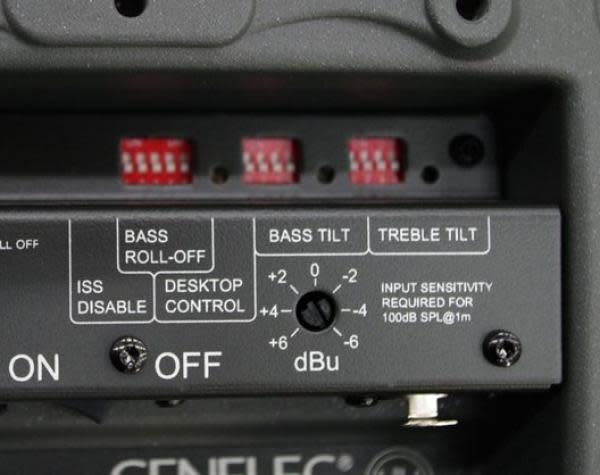
Wenn diese Funktion nicht genutzt werden soll, kann ISS™ deaktiviert werden, indem der DIP-Schalter "ISS Disable" auf der Rückseite in die Position "ON" gestellt wird. In diesem Modus wird der Monitor nur über den Netzschalter ein- und ausgeschaltet.
Beachten Sie, dass der Netzschalter den Monitor immer vollständig ausschaltet.
Nachfolgend finden Sie eine Liste der Bedingungen, die verhindern, dass der Monitor oder Subwoofer in den ISS-Ruhezustand versetzt wird:
- Am Analogeingang wird ein Signal erkannt.
- Am Digitaleingang wird ein Signal erkannt. Das kann auch das Clocking-Signal Ihrer Quelle sein, das auch anliegt, wenn kein Audio wiedergegeben wird.
- Das GLM-Netzwerk ist aktiv und GLM läuft. GLM 5 bietet eine eigene ISS Funktion an.
- ISS ist deaktiviert.
Es ist üblich, dass digitale Audioquellen das Clocking-Signal senden, sobald die Quelle eingeschaltet ist. Dies verhindert, dass der Monitor oder Subwoofer in den Ruhezustand übergeht. Es könnte auch ein Rauschen im analogen Eingangssignal vorhanden sein, das den Ruhezustand von ISS verhindert. Um herauszufinden, an welchem Eingang ein Signal anliegt, das das Umschalten in den ISS-Ruhezustand verhindert, entfernen Sie jedes Kabel einzeln und prüfen Sie, ob der ISS-Ruhezustand aktiviert wird.
Gehäuse mit Minimum Diffraction Enclosure (MDE™)-Technologie für eine unverfälschte Klangwiedergabe.

Ein häufiges Problem bei Standard-Standlautsprechern ist, dass die Unregelmäßigkeiten in der Schallwand zu Beugungen führen und die scharfen Ecken des Lautsprechers als sekundäre Schallquellen wirken.
Um die Linearität des Frequenzgangs und die Leistung freistehender Lautsprechersysteme zu verbessern, hat Genelec ein hochinnovatives Gehäuse entwickelt, das auf die Eigenschaften der Monitortreiber abgestimmt ist und abgerundete Kanten sowie eine sanft gewölbte Front und Seitenwände aufweist. Neben der unübertroffenen Linearität des Frequenzgangs sorgt das Gehäuse für eine hervorragende Abbildung.
Um eine glatte und elegant gewölbte Gehäuseoberfläche zu erreichen und die Außenabmessungen des Gehäuses zu reduzieren, während gleichzeitig das Innenvolumen für einen verbesserten Wirkungsgrad im Tieftonbereich maximiert wird, haben wir ein Gehäuse aus Aluminiumdruckguss entwickelt. Aluminium ist leicht, steif und sehr einfach zu dämpfen, um eine "tote" Struktur zu erhalten. Die Gehäusewände können relativ dünn ausgeführt werden und bieten gleichzeitig eine gute EMV-Abschirmung und eine hervorragende Wärmeableitung für die Endverstärker. Der Druckguss besteht aus zwei Teilen, der Vorder- und der Rückseite, die für eventuelle Wartungsarbeiten leicht zu trennen sind.
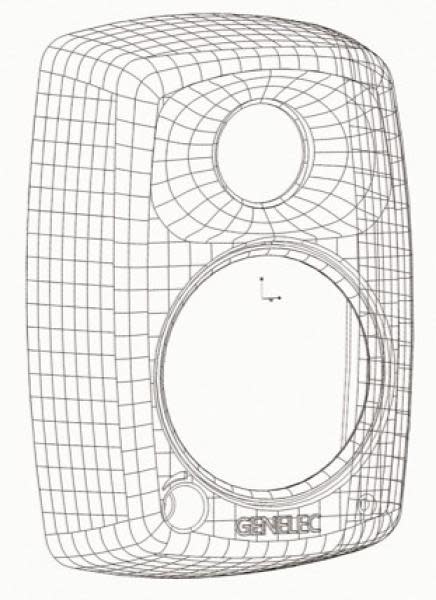
Der DCW-Waveguide wurde in das MDE-Aluminiumgehäuse integriert, um eine bessere Kontrolle über die Richtwirkung des Lautsprechers zu ermöglichen. Grundsätzlich wird die niederfrequente Grenze für eine konstante Richtcharakteristik durch die Größe der Schallführung bestimmt, d. h. je größer die Oberfläche, desto besser die Kontrolle. Mit einer sehr kontrollierten Abstrahlung auf und außerhalb der Achse wird die Hörzone konsistent, was besonders bei Mehrkanal-Anwendungen von größter Bedeutung ist. Die kontrollierte Richtwirkung reduziert auch mögliche Reflexionen erster Ordnung an Oberflächen in der Nähe des Lautsprechers und trägt so zu einer konsistenten Audiowiedergabe in unterschiedlichen akustischen Umgebungen bei. Die gesamte vordere Schallwand ist sanft gewölbt und die akustisch transparenten Schutzgitter fügen sich optisch perfekt in die verschiedenen anderen gewölbten Oberflächen ein.

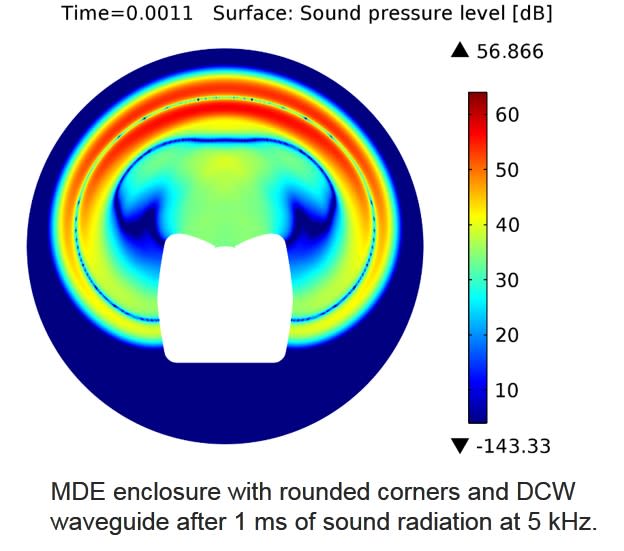
Jeder Treiber wird von einem eigenen, optimierten Verstärker angesteuert.

Elektronische Frequenzweichen ermöglichen es, das Audiosignal in einzelne Frequenzbänder aufzuteilen, die separat an einzelne Leistungsverstärker geleitet werden können, die dann an spezielle, für ein bestimmtes Frequenzband optimierte Schallwandler angeschlossen werden.
In einem typischen 2-Wege-Lautsprechersystem benötigt die aktive Frequenzweiche zwei Leistungsverstärker - einen für den Tieftöner und einen für den Hochtöner. Die Leistungsverstärker werden direkt an die Chassis eines Aktivlautsprechers angeschlossen, wodurch die Belastung des Leistungsverstärkers viel einfacher ermittelt werden kann. Jeder treiberspezifische Leistungsverstärker hat nur einen begrenzten Frequenzbereich zu verstärken (der Leistungsverstärker wird nach der aktiven Frequenzweiche platziert), was die Konstruktion noch einfacher macht.
Das Aktivprinzip bietet mehrere Vorteile:
- Die Leistungsverstärker sind direkt mit den Lautsprechertreibern verbunden, wodurch die Kontrolle durch die Dämpfung des Leistungsverstärkers auf die Schwingspule des Treibers maximiert und die Folgen dynamischer Änderungen der elektrischen Eigenschaften des Treibers verringert werden. Dies kann das Einschwingverhalten des Systems verbessern.
- Der Leistungsbedarf des Endverstärkers ist geringer. Da in den passiven Frequenzweichen-Filterkomponenten keine Energie verloren geht, wird die erforderliche Verstärkerleistung erheblich reduziert (in einigen Fällen um bis zu 50%), ohne dass die akustische Leistung des Lautsprechersystems verringert wird. Dadurch können Kosten gesenkt und die Audioqualität und Zuverlässigkeit des Systems erhöht werden.
- Kein Verlust zwischen Verstärker und Treibereinheiten führt zu einer maximalen akustischen Effizienz
- Mit aktiver Technologie kann eine überragende Klangleistung im Verhältnis zur Größe und zur Leistung bei niedrigen Frequenzen erzielt werden
- Alle Lautsprecher werden als werkseitig aufeinander abgestimmtes System geliefert (Verstärker, Frequenzweichen-Elektronik und Gehäuse-Treiber-Systeme)
Hochentwickelte Schutzschaltungen für die Treiber garantieren einen sicheren Betrieb.
In kritischen Produktionsumgebungen ist es unerlässlich, dass Abhörsysteme jederzeit zuverlässig und voll funktionsfähig arbeiten. Einer der Hauptgründe für den großen Erfolg von Genelec in Rundfunk- und Fernsehumgebungen ist die Zuverlässigkeit unserer Produkte. Ein Schlüsselelement für diese Zuverlässigkeit ist die interne Schutzschaltung, die seit 1978 in allen Produkten enthalten ist.
Die Schutzschaltung verhindert Treiberausfälle, indem sie Signalpegel erkennt und bei plötzlichen Pegelspitzen oder konstant zu hohen Pegeln den Signalpegel automatisch absenkt. Natürlich beeinträchtigt diese Funktion in keiner Weise die Klangqualität der Lautsprecher, wenn sie innerhalb der Spezifikationen arbeiten, sondern verhindert nur, dass zu hohe Eingangssignale den Lautsprecher zerstören.
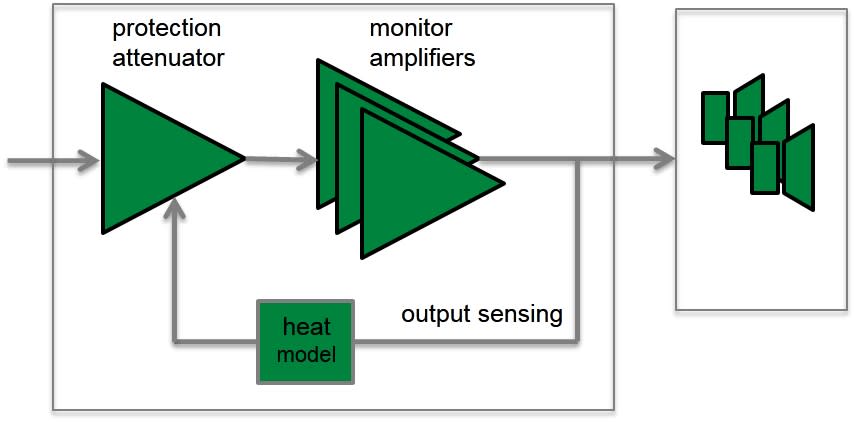
Merkmale und Vorteile der Schutzschaltungen:
- Reduziert den Ausgangspegel bei Bedarf (z. B. wenn die Temperatur der Schwingspule des Treibers den sicheren Grenzwert erreicht), was die Zuverlässigkeit des Systems erheblich verbessert
- Geeignete Schutzschaltungen in allen Lautsprechern und Subwoofern ermöglichen eine Maximierung des Systemausgangsschallpegels.
6040R setup guide
Introducing the 6040R Smart Active Loudspeaker
The end for all smaller passive speakers! - Genelec 6040R Review
Genelec 6040R | Designer Harri Koskinen on breaking the mould
Genelec 6040R loudspeakers | Connecting to a music streamer & TV
Genelec 6040R loudspeakers | Choosing the best sounding position
Genelec 6040R loudspeakers | A grand story of elegant design
Genelec 6040R loudspeakers | Calibrating with a GLM kit
Genelec 6040R loudspeakers | Adding a subwoofer to your system
SAM for Home Audio | Genelec Loudspeaker Manager explained
SAM for Home Audio | Smart Active Monitoring Technology explained
SAM for Home Audio | Auto-calibrating Genelec's high-end systems
Introducing the 6040R Smart Active Loudspeaker
Twenty years after its original launch, we explain how we’ve re-imagined the timeless 6040 floor-standing loudspeaker to bring you the 6040R: a home audio listening experience like no other.
The end for all smaller passive speakers! - Genelec 6040R Review
Genelec 6040R review by @DarkoAudio
SAM for Home Audio | Genelec Loudspeaker Manager explained
Genelec’s Smart Active Monitoring Technology, used in conjunction with our GLM Kit and free calibration software, makes fine-tuning your home listening system a simple, effective and ultimately satisfying experience. No longer will you be at the mercy of your room’s negative acoustic effects, enabling you to enjoy your favourite audio with the fullness, clarity and control that you desire.
SAM for Home Audio | Smart Active Monitoring Technology explained
Genelec’s Smart Active Monitoring Technology, used in conjunction with our GLM Kit and free calibration software, makes fine-tuning your home listening system a simple, effective and ultimately satisfying experience. No longer will you be at the mercy of your room’s negative acoustic effects, enabling you to enjoy your favourite audio with the fullness, clarity and control that you desire.
SAM for Home Audio | Auto-calibrating Genelec's high-end systems
In this video, Genelec expert, Marcel Schechter, explains what Genelec’s SAM (Smart Active Monitoring) Technology is and how the various loudspeaker models that incorporate it can be used to create the perfect home listening experience.
Händler finden

Dokumentation
Testberichte
HiFi Test - Gerät des Jahres 2025 Hifitest.de: 6040R Review Audiobeats.de: 6040R ReviewFAQ
The 6040R is a two-way floor standing smart active loudspeaker. It’s a re-engineered version of the original 6040A loudspeaker model with award-winning industrial design by Harri Koskinen, now with professional bass driver technology, proprietary class D power amplification, internal DSP circuitry and close integration with GLM loudspeaker manager software.
While many customers will consider the sound quality and aesthetics of the 6040R as perfect for home audio use, performance-wise it is entirely suitable for professional monitoring applications as well. The 6040R features the same uncompromising design philosophy as all Genelec loudspeakers, and we believe that the performance requirements for good professional and home audio loudspeakers are the same.
If you want to extend the low frequency response of a 6040R system and increase its overall playback level, then adding a subwoofer is recommended. A subwoofer will not only reduce the demands on the 6040R to reproduce low frequencies (therefore increasing the ‘headroom’ of the system), using one or more subwoofers can also help produce a smoother, flatter bass response – particularly in challenging rooms.








